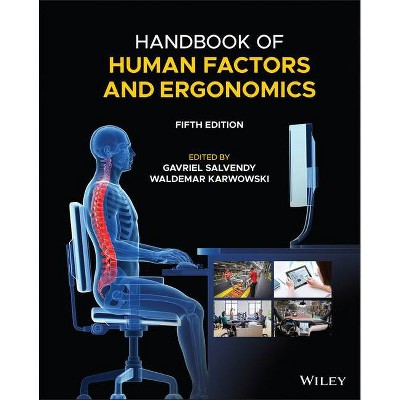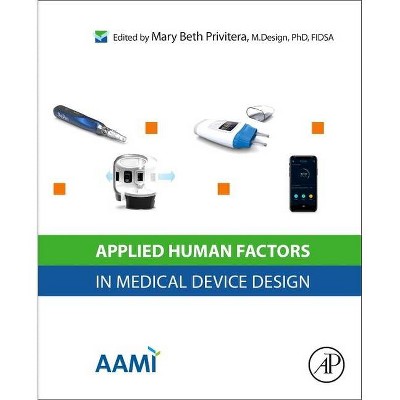Handbook of Human Factors and Ergonomics - 5th Edition by Gavriel Salvendy & Waldemar Karwowski (Hardcover)

Similar Products
Products of same category from the store
AllProduct info
<p/><br></br><p><b> Book Synopsis </b></p></br></br>In der neu Ã1/4berarbeiteten fÃ1/4nften Auflage des Handbook of Human Factors and Ergonomics präsentieren Dr. Gavriel Salvendy und Waldemar Karwowski eine umfassende Untersuchung der Gestaltung von Arbeitsumgebungen, Mensch-Maschine-Schnittstellen und die neueste Forschung zur Verringerung von Gesundheits- und Sicherheitsrisiken. Die Herausgeber haben praxisorientierte Arbeiten von einem internationalen Team fÃ1/4hrender Experten auf dem Gebiet der Ergonomie und menschlichen Faktoren zusammengestellt, die sowohl fÃ1/4r Fachleute auf diesem Gebiet als auch fÃ1/4r Sicherheitsingenieure und Spezialisten fÃ1/4r Mensch-Computer-Interaktion von Interesse sind. <p/> Das Handbuch enthält Informationen aus Ã1/4ber 7500 Quellen und bietet die neuesten Erkenntnisse zu Themen wie kÃ1/4nstliche Intelligenz, soziale Medien, Informationstechnologie und Cybersicherheit sowie Datenanalyse. In zahlreichen Fallstudien wird die praktische Anwendung der darin besprochenen Konzepte und Methoden gezeigt, und es werden die außergewöhnlichen Entwicklungen auf diesem Gebiet seit Veröffentlichung der vierten Auflage im Jahr 2012 vorgestellt. <p/> Dieses Werk bietet seinen Leserinnen und Lesern außerdem: <br> * Eine grÃ1/4ndliche EinfÃ1/4hrung in die Wirkung der menschlichen Faktoren, insbesondere im Bereich menschliche Faktoren und Ergonomie sowie Gestaltung und Integration menschlicher Systeme<br> * Eine Untersuchung der Grundlagen menschlicher Faktoren, darunter Empfindung und Wahrnehmung, Auswahl und Handlungskontrolle, Informationsverarbeitung und mentale Belastung<br> * Erwägungen zur Gestaltung von AusrÃ1/4stung, Aufgaben, Tätigkeiten und Arbeitsumgebungen, insbesondere der Arbeitsplatzgestaltung, Analyse und Gestaltung von Aufgaben und der Nutzung von Schulungssystemen<br> * Eine eingehende Betrachtung der Gestaltung im Hinblick auf Gesundheit, Sicherheit und Komfort, vor allem hinsichtlich Muskel-Skelett-Erkrankungen im unteren RÃ1/4ckenbereich und in den oberen Extremitäten sowie bei der Verwendung von persönlicher SchutzausrÃ1/4stung <p/> Das Handbook of Human Factors and Ergonomics eignet sich perfekt fÃ1/4r Ingenieure, die sich mit den Bereichen Ergonomie und menschliche Faktoren beschäftigen, und zwar auf jeder Ebene ihrer Laufbahn. Es hat auch einen Platz in den Bibliotheken von Fachleuten verdient, die in den Bereichen Designtechnik, angewandte Psychologie und Mensch-Computer-Interaktion tätig sind, sowie von Leitern von Konstruktions- und Technikabteilungen, Sicherheitsfachleuten und Industriehygienikern.<p/><br></br><p><b> From the Back Cover </b></p></br></br><p><b>Discover the latest developments in ergonomics and human factors with the newest edition of this market leading reference </b></p><p>In the newly revised Fifth Edition of <i>Handbook of Human Factors and Ergonomics</i>, Drs. Gavriel Salvendy and Waldemar Karwowski deliver a comprehensive exploration of workplace environment design, human-machine interfaces, and cutting-edge research on the reduction of health and safety risks. The editors have compiled practical material from an international team of leading experts in ergonomics and human factors that will benefit specialists in the area, as well as safety engineers and human-computer interaction specialists. </p><p> The <i>Handbook</i> includes information culled from over 7500 sources and features brand new coverage in areas like artificial intelligence, social media, information technology and cybersecurity, and data analytics. Numerous case studies demonstrate the real-world application of the concepts and methods discussed within and showcase the extraordinary developments in the field since the publication of the Fourth Edition in 2012. </p><p>Readers will also benefit from the inclusion of: </p><ul><li>A thorough introduction to the human factors function, including the discipline of human factors and ergonomics and human systems design and integration</li><li>An exploration of the fundamentals of human factors, including sensation and perception, selection and action control, information processing, and mental workload</li><li>Discussions of the design of equipment, tasks, jobs, and environments, including workplace design, task analysis and design, and training systems</li><li>An in-depth treatment of design for health, safety, and comfort, including low-back and upper extremity musculoskeletal disorders and the use of personal protective equipment</li></ul><p> Perfect for ergonomics and human factors engineers at any level of their careers, <i>Handbook of Human Factors and Ergonomics</i> will also earn a place in the libraries of design engineers, applied psychologists, human-computer interaction specialists, engineering and technology managers, and safety professionals and industrial hygienists.</p><p/><br></br><p><b> Review Quotes </b></p></br></br><br><i>Review of the fifth edition by Thomas B. Sheridan, Ford Professor Emeritus of Engineering and Applied Psychology, </i><i>MassachusettsInstitute of Technology</i><br />The fifth edition of the <i><b>Handbook of Human Factors and Ergonomics</b></i> is the most authoritative and comprehensive reference work in the field.<br /><br /><i>Review of the fourth edition and comment on the fifth edition by</i> Donald A. Norman, Director and Co-Founder, University of California, San Diego Design Lab.<br />I'm often asked for reading suggestions, especially for references to the literature on Human Factors and Ergonomics. In the past few months, I have been reading chapters of one book that has it all: Gavriel Salvendy's massive tome, the <i><b>Handbook of Human Factors and Ergonomics</b></i>. The articles are all excellent. They all reflect up-to-date reviews of the areas they cover. They are wonderful self-study material, wonderful references, and would make excellent material in multiple courses. Consider it as essential piece of professional equipment. <br />If you don't know human factors, this is a great way to find the parts relevant to your work. And even if you are an expert, this book will be valuable because it is unlikely that you are expert at all the topics covered here, yet very likely you will need some of the ones you are not (yet) expert at. <br />I follow my own advice. I consider myself an expert (I am a Fellow of the Human Factors Society), but I still learn each time I read from these pages. <br />The 5th edition has new - and very important - chapters written by the authorities in each topic. It has kept up with the times and become even more valuable as both a text and a reference.<br /><br /><i>From the Foreword to the second edition by John F. Smith, Jr., Chairman of the Board, Chief Executive Officer and</i><br /><i>President, General Motors Corporation</i><br />The publication of this second <i><b>Handbook of Human Factors and Ergonomics</b></i> is very timely. It is a comprehensive guide that contains practical knowledge and technical background on virtually all aspects of physical, cognitive, and social ergonomics. As such, it can be a valuable source of information for any individual or organization committed to providing competitive, high-quality products and safe, productive work environments.<br /><br /><i>From the Foreword to the first edition by E. M. Estes, Retired President, General Motors Corporation</i><br />Regardless of what phase of the economy a person is involved in, this handbook is a very useful tool. Every area of human factors from environmental conditions and motivation to the use of new communications systems, robotics, and business systems is well covered in the handbook by experts in every field.<br><p/><br></br><p><b> About the Author </b></p></br></br><p><b>Gavriel Salvendy, PhD, </b> is University Distinguished Professor at the College of Engineering and Computer Science at the University of Central Florida, Founding President of the Academy of Science, Engineering, and Medicine of Florida, and a member of the National Academy of Engineering (NAE). He is also Professor Emeritus of Industrial Engineering at Purdue University and Chair Professor Emeritus and Founding Head of the Department of Industrial Engineering at Tsinghua University, Beijing, P.R. China. </p><p><b>Waldemar Karwowski, PhD, </b> is Pegasus Professor and Chairman of the Department of Industrial Engineering and Management Systems and Executive Director of the Institute for Advanced Systems Engineering at the University of Central Florida. He is a Past President of the Human Factors and Ergonomics Society and a Past President of the International Ergonomics Association (IEA). He is the recipient of three Honorary Doctorates from three countries.</p>
Price History
Price Archive shows prices from various stores, lets you see history and find the cheapest. There is no actual sale on the website. For all support, inquiry and suggestion messages communication@pricearchive.us




















